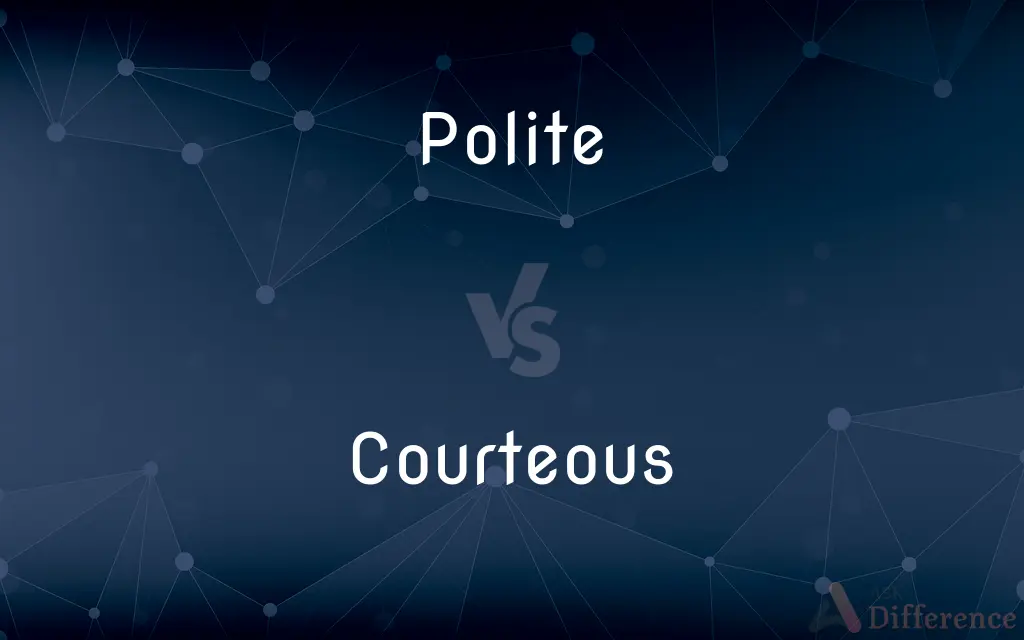Polite vs. Courteous — What's the Difference?
By Tayyaba Rehman — Updated on November 5, 2023
Polite refers to showing good manners and respect in behavior or speech. Courteous implies considerate behavior towards others, often anticipating their needs.

Difference Between Polite and Courteous
Table of Contents
ADVERTISEMENT
Key Differences
Polite behavior is about adhering to cultural norms and showing respect through one’s actions and words. It often involves saying "please" and "thank you" and can be as simple as not speaking out of turn. Courteous actions go a step further, involving thoughtful gestures like holding the door open for someone else, indicating a mindful consideration of others.
Being polite can be demonstrated through a respectful tone of voice and careful choice of words to avoid offending. Courteousness, on the other hand, embodies a deeper level of kindness, such as offering one’s seat to another person, showing a readiness to put someone else’s comfort ahead of one’s own.
In some contexts, politeness can be seen as surface-level etiquette, necessary in social and professional interactions. Courteousness is often viewed as genuine care and concern for others, potentially creating a more lasting impression of one's character.
Politeness can sometimes be performed out of obligation or to adhere to societal expectations, whereas courteousness is generally motivated by a sincere wish to be considerate and helpful to others. Thus, while all courteous acts are polite, not all polite acts necessarily qualify as courteous.
A polite individual avoids causing inconvenience or discomfort to others. A courteous individual actively works to ease others' discomfort and goes beyond basic manners to show empathy and concern for people's well-being.
ADVERTISEMENT
Comparison Chart
Definition
Showing good manners
Showing thoughtfulness and consideration
Focus
Respectful behavior and speech
Kind gestures and anticipatory actions
Motivation
Adherence to social norms
Genuine care for others
Depth
Surface-level etiquette
In-depth consideration and help
Examples
Saying "please" and "thank you"
Offering your seat to someone
Compare with Definitions
Polite
Exhibiting good manners through actions or speech.
She was polite to the guests, greeting each one personally.
Courteous
Possessing a thoughtful and kind nature in social interactions.
In all his emails, he was courteous, often starting and ending with a kind word.
Polite
Marked by an appearance of consideration and respect.
He gave a polite nod in response to the question.
Courteous
Demonstrating politeness in one's attitude and behavior towards others.
She was always courteous, making sure everyone felt included in the conversation.
Polite
Reflecting a conscientious adherence to social norms.
At the interview, she was polite and answered all the questions succinctly.
Courteous
Showing attentiveness to others' comfort and needs.
The hotel staff were courteous, attending to every request with promptness.
Polite
Behaving in a way that is socially correct and shows an understanding of and care for other people's feelings.
He was polite enough to apologize when he bumped into her.
Courteous
Marked by gestures of good will and generosity.
The driver was courteous, waiting patiently as the ducklings crossed the road.
Polite
Marked by or showing consideration for others and observance of accepted social usage.
Courteous
Characterized by a considerate and respectful approach towards others.
He was courteous and offered his help to the elderly neighbor.
Polite
Refined; elegant
Polite society.
Courteous
Characterized by gracious consideration toward others.
Polite
Well-mannered, civilized.
It's not polite to use a mobile phone in a restaurant.
Courteous
Showing regard or thought for others; especially, displaying good manners or etiquette.
A courteous gentleman
A courteous gesture
Polite
(obsolete) Smooth, polished, burnished.
Courteous
Of courtlike manners; pertaining to, or expressive of, courtesy; characterized by courtesy; civil; obliging; well bred; polite; affable; complaisant.
A patient and courteous bearing.
His behavior toward his people is grave and courteous.
Polite
To polish; to refine; to render polite.
Courteous
Exhibiting courtesy and politeness;
A nice gesture
Polite
Smooth; polished.
Rays of light falling on a polite surface.
Courteous
Characterized by courtesy and gracious good manners;
If a man be gracious and courteous to strangers it shows he is a citizen of the world
Polite
Smooth and refined in behavior or manners; well bred; courteous; complaisant; obliging; civil.
He marries, bows at court, and grows polite.
Polite
Characterized by refinement, or a high degree of finish; as, polite literature.
Polite
To polish; to refine; to render polite.
Polite
Showing regard for others in manners, speech, behavior, etc.
Polite
Marked by refinement in taste and manners;
Cultivated speech
Cultured Bostonians
Cultured tastes
A genteel old lady
Polite society
Polite
Not rude; marked by satisfactory (or especially minimal) adherence to social usages and sufficient but not noteworthy consideration for others;
Even if he didn't like them he should have been civil
Polite
Free from rudeness or displaying courteous comportment.
She sent a polite reminder about the upcoming meeting.
Common Curiosities
What characterizes a courteous person?
A courteous person is thoughtful and considerate, often going out of their way to help others.
Is saying "thank you" polite or courteous?
Saying "thank you" is polite, and it can be courteous depending on the context and sincerity.
Can someone be polite without being courteous?
Yes, one can follow social etiquette politely without engaging in the thoughtful acts that define courteousness.
How does one show courteousness at work?
By being attentive to colleagues' needs and offering assistance without being asked.
Is courteous behavior always appropriate?
Courteous behavior is generally seen as appropriate and respectful in all settings.
Why is it important to be polite?
Politeness helps to facilitate smooth and respectful communication in society.
What does being polite mean?
Being polite means showing respect and good manners in social interactions.
Is it possible to learn to be more courteous?
Yes, courteousness can be learned by actively practicing thoughtfulness and empathy.
Do cultural norms affect what is considered polite or courteous?
Absolutely, cultural norms heavily influence perceptions of politeness and courteousness.
In what ways can technology be used to be polite or courteous?
Technology can be used to send polite communications or facilitate courteous actions like sending reminders or thank-you notes.
Can you be too polite?
Excessive politeness can sometimes come off as insincere or distancing.
How are children taught to be polite and courteous?
Children are taught through modeling by adults and instruction on good manners and considerate behavior.
Are there any downsides to being polite or courteous?
Overemphasis on politeness or courteousness may occasionally mask genuine feelings or lead to misunderstandings in some cultures.
Does being polite ensure courteousness?
Being polite is a component of courteousness but doesn’t ensure the active thoughtfulness that courteousness entails.
What is the relationship between courteousness and customer service?
Courteousness is crucial in customer service as it involves making customers feel valued and respected.
Share Your Discovery

Previous Comparison
Grille vs. Grill
Next Comparison
Scope vs. BreadthAuthor Spotlight
Written by
Tayyaba RehmanTayyaba Rehman is a distinguished writer, currently serving as a primary contributor to askdifference.com. As a researcher in semantics and etymology, Tayyaba's passion for the complexity of languages and their distinctions has found a perfect home on the platform. Tayyaba delves into the intricacies of language, distinguishing between commonly confused words and phrases, thereby providing clarity for readers worldwide.













































